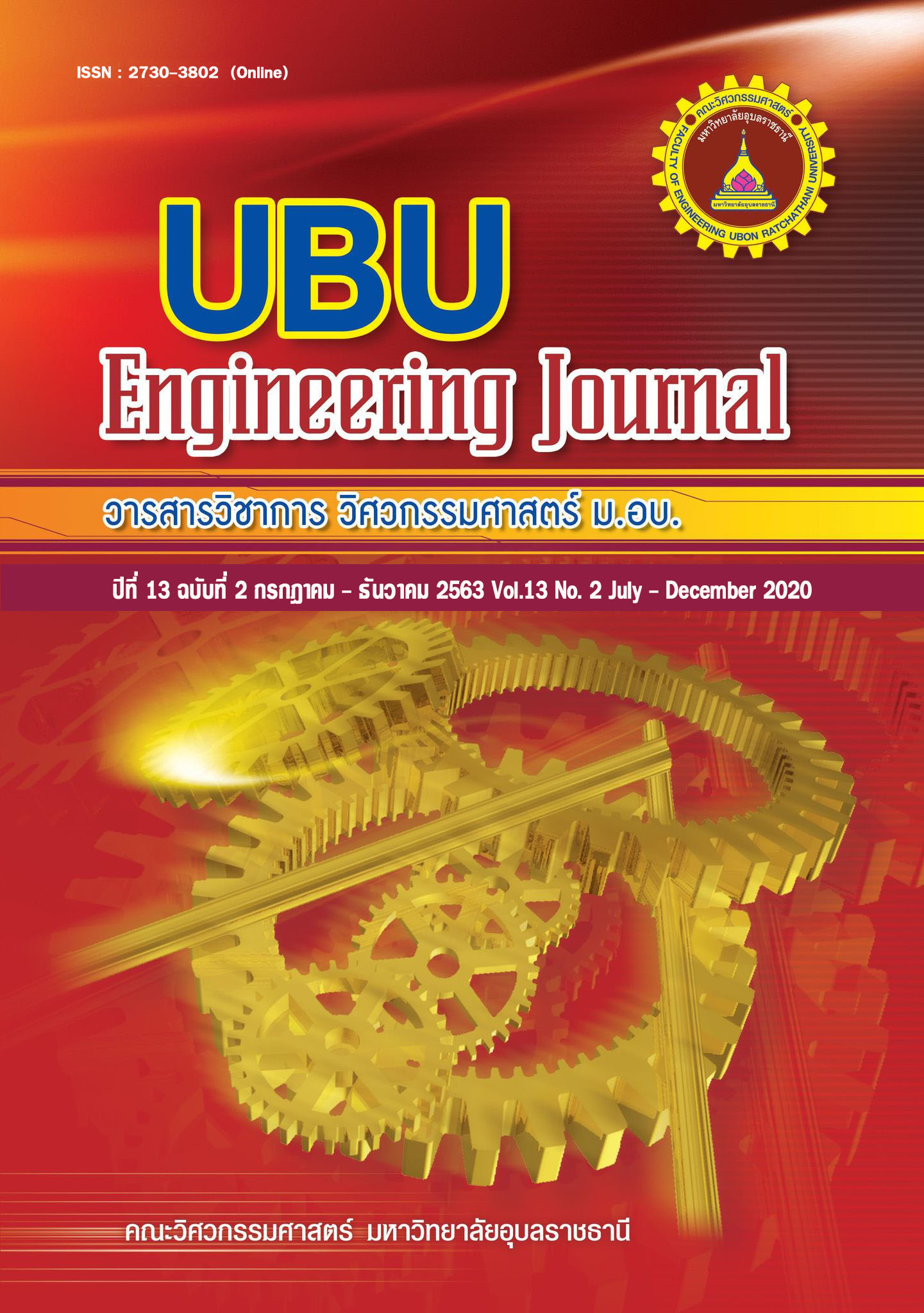Manganese removal from groundwater using powdered activated carbon-added barium alginate entrapped cells
Main Article Content
Abstract
Manganese contamination causes problem for water consumption. This research aims to investigate manganese removal using entrapped microbial cells. The influence of an activated carbon content and a microbial cell density in entrapment material on manganese removal was focused. Streptomyces violarus strain SBP1 (a biological manganese-oxidizing bacterium) and barium alginate supplemented with powdered activated carbon (entrapment material) were chosen. The experiment divided into 3 parts, including 1) manganese removal by barium alginate supplemented with powdered activated carbon (1, 5, and 10%, w/v), 2) manganese removal by the powdered activated carbon-barium alginate-entrapped cells at different microbial cell densities (100, 200, and 500 mg/L), and 3) entrapped cell micro-structural investigation using scanning electron microscope. The result showed that microbial cell density and powdered activated carbon supplement obviously affected manganese removal efficiency. Barium alginate with 5% powdered activated carbon supplement provided the highest manganese removal (42%). The powdered activated carbon-barium alginate-entrapped cells at microbial cell density of 200 mg/L gave the best manganese removal (51%). Micro-structural observation showed that powdered activated carbon and microbial cells distributed over the material. These results could be used as a fundamental information for entrapped cell application for water treatment system in the future.
Article Details
References
PCD (Pollution Control Department), Thailand state of pollution report 2015. Bangkok: Pollution Control Department, Ministry of Natural Resources and Environment; 2015.
Tobiason EJ, Bazilio A, Goodwill J, Mai X, Nguyen C. Manganese removal from drinking water sources. Current Pollution Reports. 2016; 2(3): 168-177.
Bjørklund G, Chartrand MS, Aaseth J. Manganese exposure and neurotoxic effects in children. Environmental Research. 2017; 155: 380-384.
WHO (World Health Organization). Guidelines for drinking water quality. Geneva: WHO Press; 1998.
Zhu XI, Getting T, Bruce D. Review of biologically active filters in drinking water applications. Journal of American Water Works Association. 2010; 102(12): 67-77.
สุมนา ราษฎร์ภักดี. เทคโนโลยีชีวภาพสิ่งแวดล้อม. ขอนแก่น: คณะวิศวกรรมศสตร์ มหาวิทยาลัยขอนแก่น; 2558.
Siripattanakul S, Khan E. Emerging Environmental Technologies Volume 2. New York: Springer; 2010.
Kourkoutas Y, Bekatorou A, Banat IM, Marchant R, Koutinas AA. Immobilization technologies and support materials suitable in alcohol beverages production: A review. Food Microbiology. 2004; 21(4): 377-397.
Mørch YA, Donati I, Strand BL, Skjåk-Braek G. Effect of Ca2+, Ba2+, and Sr2+ on alginate microbeads. Biomacromolecules. 2006; 7(5): 1471-1480.
Hill CB, Khan E. A comparative study of immobilized nitrifying and co-immobilized nitrifying and denitrifying bacteria for ammonia removal of sludge digester supernatant. Water, Air, and Soil Pollution. 2008; 195(1-4): 23-33.
Hassan AF, Abdel-Mohsen AM, Fouda MMG. Comparative study of calcium alginate, activated carbon, and their composite beads on methylene blue adsorption. Carbohydrate Polymers. 2014; 102(1): 192-198.
Jittawattanarat R, Kostarelos K, Khan E. Immobilized-cell-augmented activated sludge process for treating wastewater containing hazardous compounds. Water Environment Research. 2007; 79(5): 461-471.
Therdkiattikul N, Taweetanawanit P, Ratpukdi-Siripattanakul S. Screening of manganese-oxidizing bacteria from sand filter and soil, Khon Kaen, Thailand. IWA World Water Congress & Exhibition 2018. Tokyo: IWA Publishing; 2018. 109.
Cerrato JM, Falkinham JO, Dietrich AM, Knocke WR, McKinney CW, Pruden A. Manganese-oxidizing and -reducing microorganisms isolated from biofilms in chlorinated drinking water systems. Water Research. 2010; 44(13): 3935-3945.
Ito A, Miura J-I, Ishikawa N, Umita T. Biological oxidation of arsenite in synthetic groundwater using immobilised bacteria. Water Research. 2012; 46(15): 4825-4831.
Siripattanakul-Ratpukdi S, Tongkliang T. Municipal wastewater treatment using barium alginate entrapped activated sludge: adjustment of utilization conditions. International Journal of Chemical Engineering and Applications. 2012; 3(5): 328-332.
APHA (American Public Health Association), AWWA (American Water Works Association), WEF (Water Environment Federation). Standard methods for the examination of water and wastewater. 23rd ed. Washington, DC: APHA, AWWA, WEF; 2017.
Wang B, Wan Y, Zheng Y, Lee X, Liu T, Yu Z, Huang J, Ok YS, Chen J, Gao B. Alginate-based composites for environmental applications: a critical review. Critical Reviews in Environmental Science and Technology. 2019; 49(4): 318-356.
Park HG, Kim TW, Chae MY, Yoo I-K. Activated carbon-containing alginate adsorbent for the simultaneous removal of heavy metals and toxic organics. Process Biochemistry. 2007; 42(10): 1371-1377.
Choi J-W, Yang K-S, Kim D-J, Lee CE. Adsorption of zinc and toluene by alginate complex impregnated with zeolite and activated carbon. Current Applied Physics. 2009; 9(3): 694-697.
Sigdel A, Jung W, Min B, Lee M, Choi U, Timmes T, Kimb S-J, Kang C-U, Kumar R, Jeon B-H. Concurrent removal of cadmium and benzene from aqueous solution by powdered activated carbon impregnated alginate beads. Catena. 2017; 147: 101-107.
Arica MY, Bayramoglu G, Yilmaz M, Bektaş S, Genç O. Biosorption of Hg2+, Cd2+, and Zn2+ by Ca-alginate and immobilized wood-rotting fungus Funalia trogii. Journal of Hazardous Materials. 2004; 109(1-3): 191-199.
Bayramoglu G, Yakup Arica M. Construction a hybrid biosorbent using Scenedesmus quadricauda and ca-alginate for biosorption of Cu(II), Zn(II) and Ni(II): Kinetics and equilibrium studies. Bioresource Technology. 2009; 100(1): 186-193.
Pramanik S, Khan E. Effects of cell entrapment on growth rate and metabolic activity of mixed cultures in biological wastewater treatment. Enzyme and Microbial Technology. 2008; 43: 245-251.
Sheeja R Y, Murugesan T. Studies on biodegradation of phenol using response surface methodology. Journal of Chemical Technology and Biotechnology. 2002; 77(11): 1219-1230.
Taweetanawanit P, Ratpukdi T, Siripattanakul-Ratpukdia S. Performance and kinetics of triclocarban removal by entrapped Pseudomonas fluorescens strain MC46. Bioresource Technology. 2019; 274: 113-119.
Siripattanakul-Ratpukdi S, Wirojanagud W, McEvoy J, Khan E. Effect of cell-to-matrix ratio in polyvinyl alcohol immobilized pure and mixed cultures for atrazine degradation. Water, Air, and Soil Pollution. 2008; 8: 257-266.

